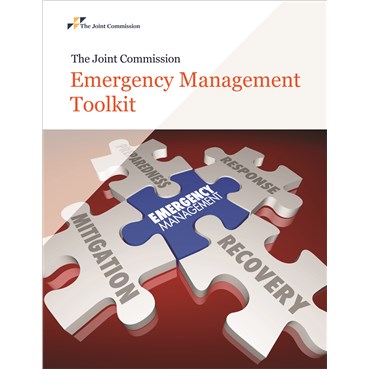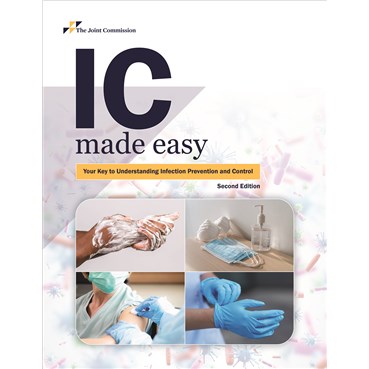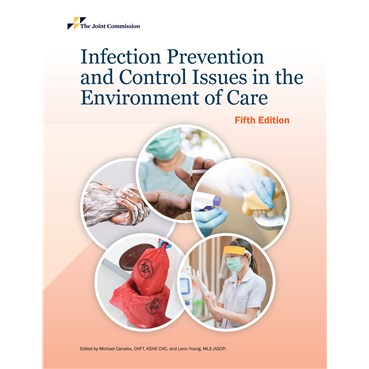Joint Commission Manual
Joint Commission Accreditation Manuals at Mayo Clinic
Web Resources
Accreditation (Mayo)
This includes access to the latest manuals
Joint Commission International Accreditation Standards for Hospitals
Journals
Joint Commission Journal on Quality and Patient Safety
If you would like to receive an e-mail alert when new issues of these journal are published, visit our Current Awareness site.
Review more information on the Current Awareness Service here.
Joint Commission Select Publications
-
 Joint Commission Emergency Management Toolkit
Focusing on the need for health care organizations to prepare for and manage all types of emergencies, this brand-new toolkit includes checklists, exercise scenarios and drills, after-action reports, and best-practices for an all-hazards approach to emergency management.
Call Number: RA645.5 .J63 2024x
Joint Commission Emergency Management Toolkit
Focusing on the need for health care organizations to prepare for and manage all types of emergencies, this brand-new toolkit includes checklists, exercise scenarios and drills, after-action reports, and best-practices for an all-hazards approach to emergency management.
Call Number: RA645.5 .J63 2024x -
 IC made easy : your key to understanding infection prevention and control
A practical introduction to infection prevention and control (IC) concepts, containing hands-on strategies for complying with key infection prevention and control standards and related requirements.
Call Number: RA969 .I12 2023
IC made easy : your key to understanding infection prevention and control
A practical introduction to infection prevention and control (IC) concepts, containing hands-on strategies for complying with key infection prevention and control standards and related requirements.
Call Number: RA969 .I12 2023 -
 Infection Prevention and Control Issues in the Environment of Care
Understand the connections between infection prevention and control and proper management of the physical environment to protect patients, staff, and visitors from infection. New edition of JCR best seller and Doody's Core Title.
Call Number: RA969 .I53 2023x
Infection Prevention and Control Issues in the Environment of Care
Understand the connections between infection prevention and control and proper management of the physical environment to protect patients, staff, and visitors from infection. New edition of JCR best seller and Doody's Core Title.
Call Number: RA969 .I53 2023x -
 Front Line of Defense: the role of nurses in preventing sentinel events
This first-ever co-publication from The Joint Commission and the American Nurses Association arms frontline nurses, nurse executives, and nurse managers with practical, customer-centric strategies for identifying and preventing the most common sentinel events in hospitals, ambulatory care, behavioral health care, home care, and nursing care centers.
Call Number: RA971.38 .J65 2018x
Front Line of Defense: the role of nurses in preventing sentinel events
This first-ever co-publication from The Joint Commission and the American Nurses Association arms frontline nurses, nurse executives, and nurse managers with practical, customer-centric strategies for identifying and preventing the most common sentinel events in hospitals, ambulatory care, behavioral health care, home care, and nursing care centers.
Call Number: RA971.38 .J65 2018x -
 The APIC/JCR Infection Prevention and Control Workbook, Joint Commission Resources
This updated version of a JCR best-seller, developed and co-published in partnership with the Association for Professionals in Infection Control and Epidemiology (APIC), addresses infection prevention and control in all types of health care settings. The book discusses and clarifies Joint Commission requirements for infection prevention and control and offers a wealth of tools for organizations to assess and improve their infection prevention and control activities. Edited by infection prevention and control experts Barbara Moore Soule and Kathleen Meehan Arias, and written by a host of practitioners, the workbook format encourages organizations to develop action plans to address infection control issues found in the self-assessment. This new edition features updated chapters and tools, including new chapters on implementing a successful surveillance program; infection prevention and control priorities in ambulatory health care; cleaning, disinfection, and sterilization of equipment, devices, and supplies, and much more. Key Topics: Designing and Managing An Effective Infection Prevention and Control Program The Role of Leadership in Infection Prevention and Control Planning for and Managing Infectious Disease Emergencies Implementing Clinical Strategies to Reduce Infection Risk Cleaning, Disinfection and Sterilization of Medical Devices and Equipment Integrating Infection Prevention and Control into Patient Safety and Performance Improvement Key Features: A wealth of infection prevention and control strategies for standards compliance, performance improvement, and patient safety Expert advice from infection preventionists from The Joint Commission, Joint Commission Resources, and the Associations for Professionals in Infection Control and Epidemiology A variety of tools, forms, and checklists throughout the text, with writable versions available on the included flash drive Coverage of all health care settings accredited by The Joint Commission Key Audience: Infection preventionists Facilities managers Accreditation professionals Patient safety officers Performance and quality improvement staff Risk managers Emergency managers Nursing staff
Call Number: RA969 .A65 2017x
The APIC/JCR Infection Prevention and Control Workbook, Joint Commission Resources
This updated version of a JCR best-seller, developed and co-published in partnership with the Association for Professionals in Infection Control and Epidemiology (APIC), addresses infection prevention and control in all types of health care settings. The book discusses and clarifies Joint Commission requirements for infection prevention and control and offers a wealth of tools for organizations to assess and improve their infection prevention and control activities. Edited by infection prevention and control experts Barbara Moore Soule and Kathleen Meehan Arias, and written by a host of practitioners, the workbook format encourages organizations to develop action plans to address infection control issues found in the self-assessment. This new edition features updated chapters and tools, including new chapters on implementing a successful surveillance program; infection prevention and control priorities in ambulatory health care; cleaning, disinfection, and sterilization of equipment, devices, and supplies, and much more. Key Topics: Designing and Managing An Effective Infection Prevention and Control Program The Role of Leadership in Infection Prevention and Control Planning for and Managing Infectious Disease Emergencies Implementing Clinical Strategies to Reduce Infection Risk Cleaning, Disinfection and Sterilization of Medical Devices and Equipment Integrating Infection Prevention and Control into Patient Safety and Performance Improvement Key Features: A wealth of infection prevention and control strategies for standards compliance, performance improvement, and patient safety Expert advice from infection preventionists from The Joint Commission, Joint Commission Resources, and the Associations for Professionals in Infection Control and Epidemiology A variety of tools, forms, and checklists throughout the text, with writable versions available on the included flash drive Coverage of all health care settings accredited by The Joint Commission Key Audience: Infection preventionists Facilities managers Accreditation professionals Patient safety officers Performance and quality improvement staff Risk managers Emergency managers Nursing staff
Call Number: RA969 .A65 2017x -
 Emergency Management in Health Care: an all-hazards approach
by
This 3rd Edition, has four main goals: To emphasize the role of leadership in emergency planning and response. To help organizations adapt to singular or escalating threats such as infectious disease outbreaks, acts of terrorism, active shooters, industrial accidents, unusual weather occurrences, and other emergencies. To expose the vulnerabilities that may impact technology in disaster responses such as failures to manage resources, utilities, and systems processes and technology advancements that may increase security in the use of electronic medical records. To update discussion of Joint Commission standards to reflect current requirements. Ed Tangredi, MHA, FACHE, CEM, Director of Emergency Management at White Plains Hospital, New York, contributes a new Foreword to the third edition. Mr. Tangredi is a nationally known speaker on emergency management, specializes in regional preparedness, and established and co-chairs the first MACE Team (Mutual Aid Coordinating Entity) in the State of New York. Key Topics Leadership s role in emergency management planning. Hazard vulnerability analysis (HVA). Emergency operations plan (EOP). Four phases of emergency management: mitigation, preparedness, response, and recovery. Six critical areas of emergency response: Communication, resources and assets, safety and security, staff responsibilities, utilities management, and patient clinical and support activities. Key Features Standards Focus A feature that addresses the most important standards in the chapter. At a Glance A short outline detailing the main concepts in each chapter. Why Is It Critical? A short explanation of the importance of each major concept addressed. Who Is Involved? A brief listing of personnel who must be or may be involved in planning activities. Community Collaboration A feature that highlights collaborative relationships and support structures for health care organizations. Vulnerable Populations A feature that identifies the populations requiring special consideration in terms of each chapters concept. Capacity Builder A feature that provides resources and links that can help in emergency planning and preparedness. In Summary A short summary of the main concepts in the chapter. Case in Point New case studies that supply lessons learned and actions applied. Key Audience This book is intended for emergency managers and others involved in the multidisciplinary planning and application of the EOP: Safety officers. Facilities managers. Medical and nursing directors. Department heads
Call Number: RA645.5 .E44 2016x
Emergency Management in Health Care: an all-hazards approach
by
This 3rd Edition, has four main goals: To emphasize the role of leadership in emergency planning and response. To help organizations adapt to singular or escalating threats such as infectious disease outbreaks, acts of terrorism, active shooters, industrial accidents, unusual weather occurrences, and other emergencies. To expose the vulnerabilities that may impact technology in disaster responses such as failures to manage resources, utilities, and systems processes and technology advancements that may increase security in the use of electronic medical records. To update discussion of Joint Commission standards to reflect current requirements. Ed Tangredi, MHA, FACHE, CEM, Director of Emergency Management at White Plains Hospital, New York, contributes a new Foreword to the third edition. Mr. Tangredi is a nationally known speaker on emergency management, specializes in regional preparedness, and established and co-chairs the first MACE Team (Mutual Aid Coordinating Entity) in the State of New York. Key Topics Leadership s role in emergency management planning. Hazard vulnerability analysis (HVA). Emergency operations plan (EOP). Four phases of emergency management: mitigation, preparedness, response, and recovery. Six critical areas of emergency response: Communication, resources and assets, safety and security, staff responsibilities, utilities management, and patient clinical and support activities. Key Features Standards Focus A feature that addresses the most important standards in the chapter. At a Glance A short outline detailing the main concepts in each chapter. Why Is It Critical? A short explanation of the importance of each major concept addressed. Who Is Involved? A brief listing of personnel who must be or may be involved in planning activities. Community Collaboration A feature that highlights collaborative relationships and support structures for health care organizations. Vulnerable Populations A feature that identifies the populations requiring special consideration in terms of each chapters concept. Capacity Builder A feature that provides resources and links that can help in emergency planning and preparedness. In Summary A short summary of the main concepts in the chapter. Case in Point New case studies that supply lessons learned and actions applied. Key Audience This book is intended for emergency managers and others involved in the multidisciplinary planning and application of the EOP: Safety officers. Facilities managers. Medical and nursing directors. Department heads
Call Number: RA645.5 .E44 2016x -
 Root Cause Analysis in Health Care: Tools and Techniques
by
Call Number: R729.8 .R6665 2015x
Root Cause Analysis in Health Care: Tools and Techniques
by
Call Number: R729.8 .R6665 2015x -
 EC made easy : your key to understanding EC, EM, and LS : environmnet of care, emergency management, life safety
by
Call Number: RA967.75 .E234 2015x
EC made easy : your key to understanding EC, EM, and LS : environmnet of care, emergency management, life safety
by
Call Number: RA967.75 .E234 2015x -
 Cultural Sensitivity: a pocket guide for health care professionals
Call Number: Pamphlet #2229
Cultural Sensitivity: a pocket guide for health care professionals
Call Number: Pamphlet #2229 -
 Patient Safety Pocket Guide
Call Number: Pamphlet #2231
Patient Safety Pocket Guide
Call Number: Pamphlet #2231
